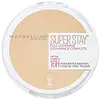What's inside
What's inside
 Key Ingredients
Key Ingredients

 Benefits
Benefits

 Concerns
Concerns

 Ingredients Side-by-side
Ingredients Side-by-side

Talc
AbrasiveOctyldodecyl Stearoyl Stearate
EmollientZinc Stearate
Cosmetic ColorantPolyethylene
AbrasiveAvena Sativa Kernel Flour
AbrasiveMica
Cosmetic ColorantCalcium Silicate
AbsorbentDimethicone
EmollientQuaternium-15
PreservativeDextrin
AbsorbentLauroyl Lysine
Skin ConditioningSodium Dehydroacetate
PreservativePropylparaben
PreservativeMethylparaben
PreservativeBHT
AntioxidantIron Oxides
Ultramarines
Talc
AbrasiveMagnesium Stearate
Cosmetic ColorantPolymethyl Methacrylate
Synthetic Fluorphlogopite
Isononyl Isononanoate
EmollientNylon-12
Hydrogenated Polydecene
EmollientVinyl Dimethicone/Methicone Silsesquioxane Crosspolymer
Diphenyl Dimethicone/Vinyl Diphenyl Dimethicone/Silsesquioxane Crosspolymer
Aluminum Hydroxide
EmollientDimethicone
EmollientPerfluorooctyl Triethoxysilane
Ethylhexylglycerin
Skin ConditioningLauroyl Lysine
Skin ConditioningMethicone
EmollientHydrogenated Palm Oil
EmollientPalmitoyl Proline
Skin ConditioningGlycerin
HumectantHydrogen Dimethicone
Water
Skin ConditioningSodium Palmitoyl Sarcosinate
CleansingMagnesium Palmitoyl Glutamate
Skin ConditioningPalmitic Acid
EmollientPhenoxyethanol
PreservativeMoringa Oleifera Seed Extract
Skin ConditioningDisodium Phosphate
BufferingCitric Acid
BufferingTocopherol
AntioxidantCI 77891
Cosmetic ColorantMica
Cosmetic ColorantCI 77491
Cosmetic ColorantCI 77492
Cosmetic ColorantCI 77499
Cosmetic ColorantTalc, Magnesium Stearate, Polymethyl Methacrylate, Synthetic Fluorphlogopite, Isononyl Isononanoate, Nylon-12, Hydrogenated Polydecene, Vinyl Dimethicone/Methicone Silsesquioxane Crosspolymer, Diphenyl Dimethicone/Vinyl Diphenyl Dimethicone/Silsesquioxane Crosspolymer, Aluminum Hydroxide, Dimethicone, Perfluorooctyl Triethoxysilane, Ethylhexylglycerin, Lauroyl Lysine, Methicone, Hydrogenated Palm Oil, Palmitoyl Proline, Glycerin, Hydrogen Dimethicone, Water, Sodium Palmitoyl Sarcosinate, Magnesium Palmitoyl Glutamate, Palmitic Acid, Phenoxyethanol, Moringa Oleifera Seed Extract, Disodium Phosphate, Citric Acid, Tocopherol, CI 77891, Mica, CI 77491, CI 77492, CI 77499
 Reviews
Reviews

Ingredients Explained
These ingredients are found in both products.
Ingredients higher up in an ingredient list are typically present in a larger amount.
Dimethicone is a type of synthetic silicone created from natural materials such as quartz.
What it does:
Dimethicone comes in different viscosities:
Depending on the viscosity, dimethicone has different properties.
Ingredients lists don't always show which type is used, so we recommend reaching out to the brand if you have questions about the viscosity.
This ingredient is unlikely to cause irritation because it does not get absorbed into skin. However, people with silicone allergies should be careful about using this ingredient.
Note: Dimethicone may contribute to pilling. This is because it is not oil or water soluble, so pilling may occur when layered with products. When mixed with heavy oils in a formula, the outcome is also quite greasy.
Learn more about DimethiconeThis ingredient comes from a fatty acid (lauric acid) and amino acid (lysine). It is used to add a silky feel to cosmetics.
According to a manufacturer, its fatty acid base leaves a silky feeling on the skin. It also has emollient properties because of this. Emollients help soften skin by preventing water from evaporating.
Lauroyl lysine is barely soluble in water.
Learn more about Lauroyl LysineMica is a naturally occurring mineral used to add shimmer and color in cosmetics. It can also help improve the texture of a product or give it an opaque, white/silver color.
Serecite is the name for very fine but ragged grains of mica.
This ingredient is often coated with metal oxides like titanium dioxide. Trace amounts of heavy metals may be found in mica, but these metals are not harmful in our personal products.
Mica has been used since prehistoric times throughout the world. Ancient Egyptian, Indian, Greek, Roman, Aztec, and Chinese civilizations have used mica.
Learn more about MicaTalc is a clay mineral. It helps absorb moisture and improve the texture of products. Like other types of clay, Talc can have a slight exfoliating effect on skin. Talc can be added to increase the volume of products.
Some Baby powders are made by combining talc with corn starch. The word "talc" comes from Latin and originates from Arabic. Talc is a mineral commonly found throughout the world.
If you have any concerns about using talc, we recommend checking out the FDA's official page.
Learn more about Talc